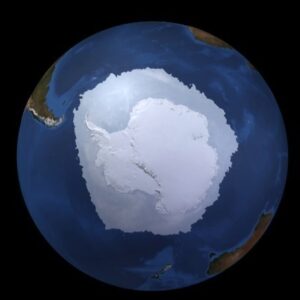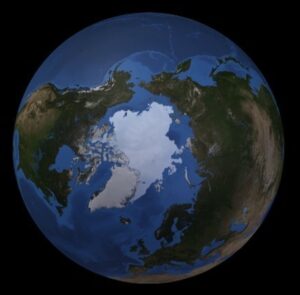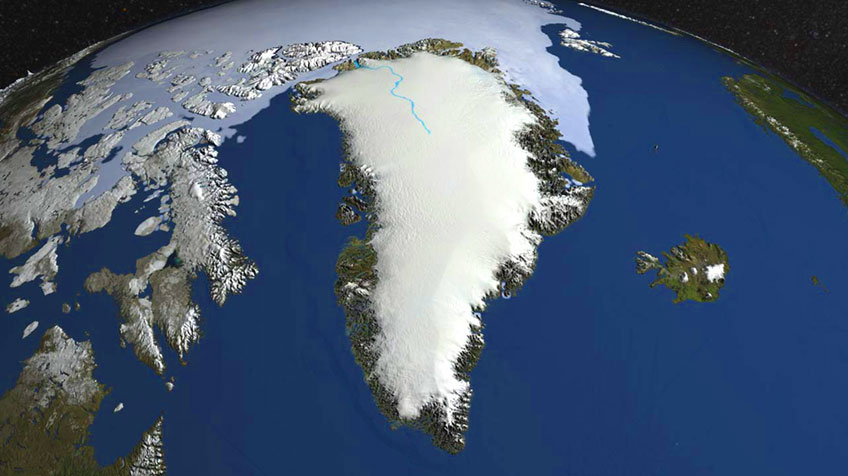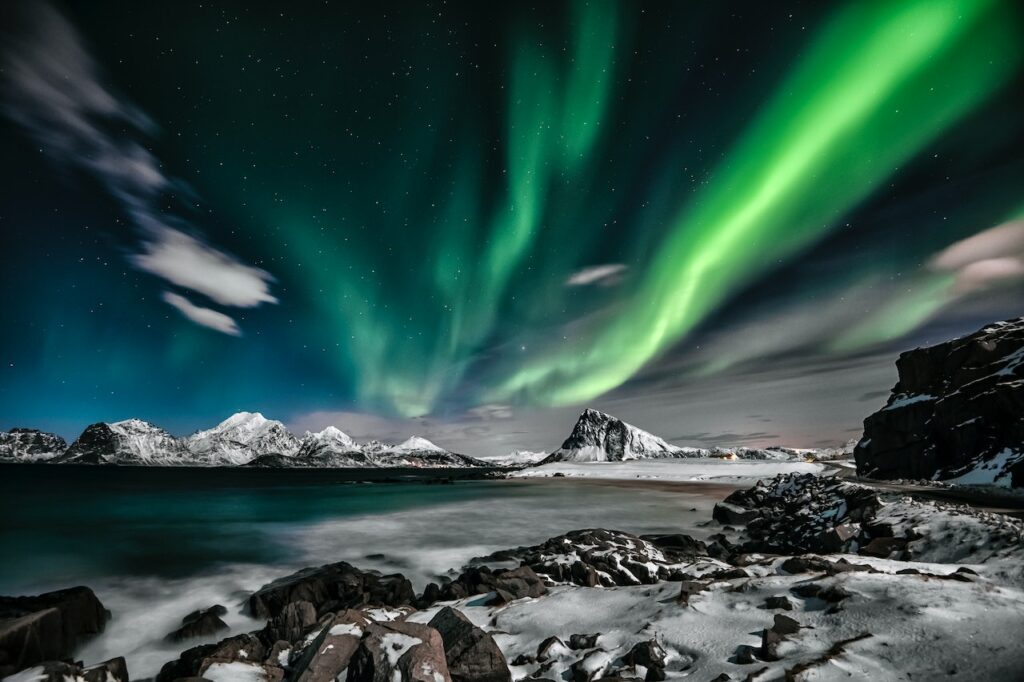

10% of water is frozen
Diversity of Ice
Sea Ice
Sea ice forms when ocean water freezes due to low temperatures. It can be found in polar regions and covers large areas of the ocean surface. Sea ice is an important part of the Earth’s climate system as it reflects sunlight and helps regulate the planet’s temperature.
= salty water
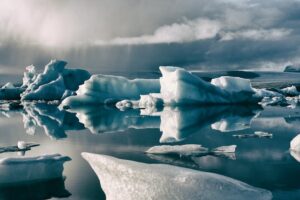
Glacier Ice
Glaciers are massive bodies of ice that form when snow accumulates over time and compresses into ice. These ice masses flow slowly under their own weight. Glacier ice can be found in mountainous regions and polar areas. They contribute to shaping landscapes through processes like erosion and deposition.
= fresh water
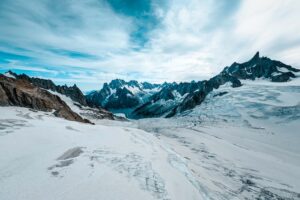
Icebergs
Icebergs are large pieces of ice that break off from glaciers and float in the ocean. Most of their mass is underwater, and they can pose hazards to ships due to their size and potential to drift into shipping lanes.
= fresh water
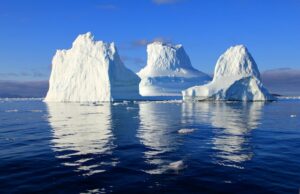
Ice Shelves
Ice shelves are extensions of glaciers that float on the ocean. They are formed where glaciers flow into the sea and their leading edges break off. These ice shelves provide stability to the glaciers that feed them.
= primarily freshwater
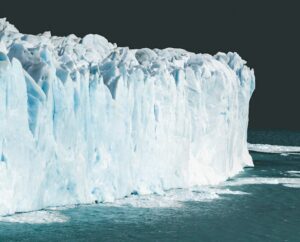
Ice Sheets
Ice sheets are vast expanses of ice that cover large portions (50,000 square kilometers) of continents. The two main ice sheets on Earth are the Antarctic Ice Sheet and the Greenland Ice Sheet. They contain the majority of the world’s freshwater and play a crucial role in regulating sea levels.
= fresh water
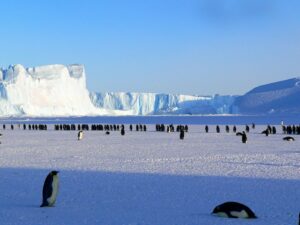
In Glasgow, they compiled a list of the word ‘snow’ in the Scots language back in 2015. The list contains 421 words! This number paints a vivid picture of the many different types of water frost and its beautiful variations.
Melting and sea level rise
ANTARTICA
Melting rate
Sea level rise
1 millimeter sea level rise = For every 360 gigatonnes of land ice lost. Approximately, the average rise in sea level per year due to the loss of 147.0 gigatons of ice mass is about 0.408 millimeters.
ARCTIC
Melting rate
Arctic sea ice is shrinking at a rate of 12.6% per decade. For every ten-year period, the Arctic sea ice is shrinking by approximately 12.6%.
Arctic sea ice melting doesn’t directly raise sea levels, as it’s already in the water. However, its decline exposes darker ocean surfaces, contributing to warming and forming a feedback loop. This loss affects regional wind patterns and ocean currents. Arctic sea ice melting has negative implications for both global warming and the stability of surrounding permafrost.
GREENLAND
Melting rate
Greenland is losing its ice sheets more rapped than Antarctica.
Ice loss from Greenland: 271 billion metric tons per year
Sea level rise
Approximately, the average rise in sea level per year due to the loss of 271 billion metric tons of ice mass from Greenland is about 0.753 millimeters.
GLACIERS
Melting rate
Annual reports reveal that glaciers in the reference network lost about 1.2 meters (3.9 feet) of water equivalent per year during 2017-2018 and 2018-2019.
No data was found for sea level rise by glaciers. Most glaciers don’t flow directly into the ocean but create the world’s sweet water rivers.
Glaciers play a crucial role in maintaining water supplies and river systems. They act as natural reservoirs, releasing meltwater during warmer months, sustaining river flow critical for agriculture, drinking water, and ecosystems. As glaciers melt due to warming, their contribution to steady water availability becomes vital for communities and ecosystems that rely on them.
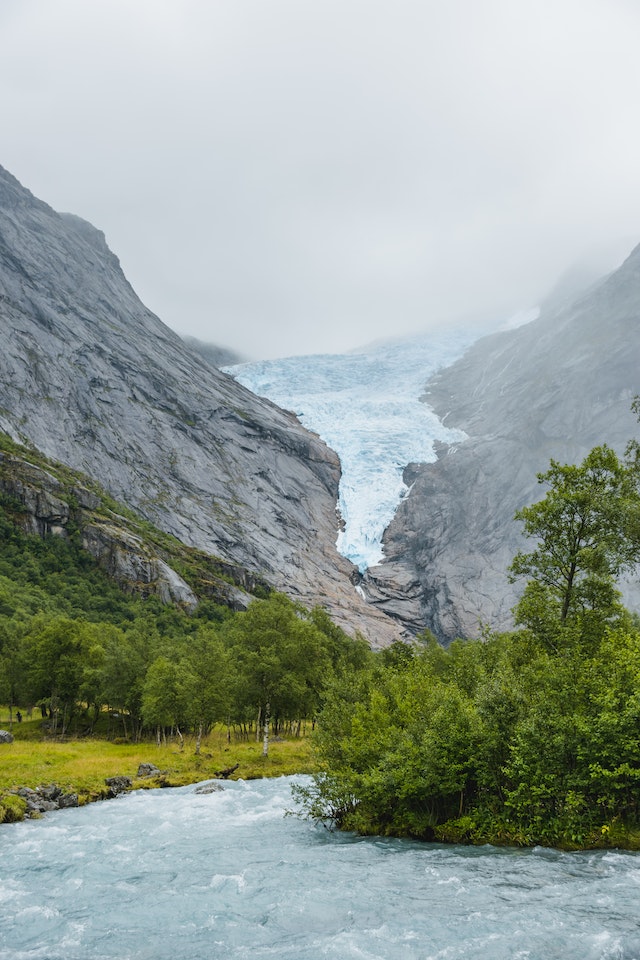
While the spotlight shines on ice sheets and sea level rise, it’s worth recognizing the profound significance of the Arctic and glaciers. The Arctic region shapes weather patterns, sustains ecosystems, and plays a critical role in global climate regulation. Likewise, glaciers—often overlooked amidst grander narratives—serve as lifelines, providing essential freshwater resources to communities, ecosystems, and agriculture. These lesser-highlighted aspects of our changing world hold intricate connections that impact both human societies and the natural environment
Global ice melting rate and sea level rise
Ice sheets are melting at a global rate of 424 billion metric tonnes per year. (NASA2023)
Sea level has risen by 4 inches or 101.6 millimeters (mm) since 1993. (NASA 2023)
The sea level rise speed changed over time: it was about 1.3 mm per year from 1901 to 1971, then rose to 1.9 mm per year from 1971 to 2006, and significantly increased to 3.7 mm per year from 2006 to 2018 (high confidence, IPCC).
IPCC, 2023: Sections. In: Climate Change 2023: Synthesis Report. Contribution of Working Groups I, II, and III to the Sixth Assessment Report of the Intergovernmental Panel on Climate Change [Core Writing Team, H. Lee and J. Romero (eds.)]. IPCC, Geneva, Switzerland, pp. 35-115, doi: 10.59327/IPCC/AR6-9789291691647 (page 46, section 2) https://www.ipcc.ch/report/ar6/syr/downloads/report/IPCC_AR6_SYR_LongerReport.pdf
Consequences of ice melting
Sea level rise
Sea level rise primarily impacts the inhabitants of islands and coastal regions. This also poses an additional problem for coral reefs and all marine life.
Fresh water in the ocean
The melting of ice, particularly from glaciers and polar ice caps, releases freshwater into the oceans. This influx of freshwater can alter the ocean's chemistry by diluting its salinity and disrupting ocean currents. These changes in salinity and circulation patterns can impact marine life, as many organisms are adapted to specific salinity levels and rely on ocean currents for nutrient distribution and reproductive cycles. Such shifts can affect marine ecosystems, potentially leading to changes in species distribution, disruptions in food chains, and overall ecosystem health.
endangering animals
The rapid changes in the Arctic due to climate change are placing both ecosystems and indigenous communities at risk. The shrinking ice cover and melting permafrost are jeopardizing the habitats of iconic Arctic species such as polar bears, walruses, arctic foxes, snowy owls, and reindeer. These animals depend on the stability of their environment for survival.
endangering indigenous people
For indigenous people in these regions, the consequences are equally dire. The reduction in opportunities for subsistence hunting, fishing, herding, and gathering disrupts their traditional ways of life and erodes vital cultural practices. Beyond the material impact, the loss of these activities can lead to psychological stresses, undermining the well-being and cohesion of these communities.
water supply of mountain glaciers
The melting of mountain glaciers poses significant concerns for our global water supply and associated sectors. These glaciers serve as crucial reservoirs of freshwater, releasing meltwater gradually throughout the year, and contributing to rivers that sustain countless communities and ecosystems downstream. The accelerated melting, driven by rising temperatures, threatens to disrupt this reliable flow, impacting agricultural irrigation, domestic water use, and industrial needs. Additionally, the reduction of glacier volume diminishes the potential for hydropower generation, a renewable energy source vital to many regions. This imbalance in water availability can lead to conflicts over resource allocation, particularly in arid and densely populated areas. The retreat of glaciers also jeopardizes fragile alpine ecosystems and biodiversity.
Less albedo, more global warming
The melting of ice, such as glaciers and Arctic sea ice, reduces Earth's albedo, which is its ability to reflect sunlight. As ice cover decreases, darker surfaces like open water or exposed land absorb more sunlight, causing the planet to warm further. This creates a feedback loop, accelerating ice melt and contributing to rising temperatures. This phenomenon has significant implications for climate change, as reduced albedo intensifies global warming and impacts ecosystems, sea levels, and weather patterns.
Methane and carbon dioxide
Methane and carbon dioxide gases can be trapped not only in permafrost but also in ice, such as ice sheets covering Greenland and Antarctica. Within ice, air bubbles containing gases from thousands of years ago are preserved within the ice layers. As global warming causes ice to melt, these ancient air bubbles are released into the atmosphere. This process contributes to an increase in the concentration of greenhouse gases, intensifying the greenhouse effect and accelerating climate change.
Permafrost
Underneath the ice layer, we find frozen ground that has stored organic matter for centuries. The melting of Arctic sea ice accelerates the melting of permafrost on the surrounding land masses. As the permafrost melts, the stored organic materials begin to decompose, releasing significant amounts of carbon dioxide and methane into the atmosphere. Additionally, the thawing can destabilize the ground, causing land subsidence and damaging infrastructure. The release of ancient dormant viruses and bacteria from the thawed permafrost also raises concerns about potential health risks.
Global climate change of the Arctic
The Arctic region exerts a profound influence on weather patterns and holds a pivotal role in global climate regulation. This impact resonates across the northern hemisphere, characterized by polar easterlies wind, the polar vortex, and the jet stream. Moreover, it extends to ocean currents, including the Atlantic Meridional Overturning Circulation (AMOC). Consequently, the Arctic's influence extends far beyond the northern hemisphere, exerting a widespread impact on global climate dynamics.
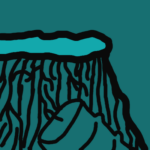
Permafrost
20% of soil is frozen
Permafrost refers to permanently frozen ground, typically found in regions with extremely cold temperatures, such as the polar regions and high mountain areas. It occurs in places where the ground remains frozen for at least two consecutive years. Permafrost is widespread in the Arctic and subarctic regions, including northern Canada, Alaska, Siberia, and parts of Scandinavia. It can also be found in high-altitude areas of mountain ranges, such as on the Tibetan Plateau the Himalayas, and the Andes.
Permafrost many consequences
Inside these frozen layers of permafrost lie incredible ancestors– plants frozen for thousands of years and even dormant viruses or bacteria. Essentially, it’s like a time capsule of frozen ground that holds a massive amount of carbon dioxide and methane. When the permafrost melts, it releases the organic material that has been trapped in frost and time.
Organic carbon
Organic carbon in northern permafrost regions is composed of methane (CH4) and carbon dioxide (CO2), both of which are greenhouse gases. When these areas warm up, the release of this gas mixture into the atmosphere intensifies global warming.
Nuclear waste
Across history, we've deposited chemical waste within this frozen terrain. Even nuclear waste found its way into Siberia's permafrost during the Cold War era. Various mines added to the issue, leaving toxic heavy metals like nickel, cadmium, and arsenic buried in the frozen ground. This accumulation of chemical and radioactive waste, originating from the Cold War period, carries the risk of harming wildlife and disturbing ecosystems, potentially being released as the permafrost thaws.
What is cryptobiosis or cryptosleep?
Organisms that undergo cryptobiosis possess an astonishing ability to endure conditions that would spell doom for most life forms. They can withstand the absence of water or oxygen, endure extreme temperatures, endure freezing, and even survive in extremely salty environments. In this state, they exist in a realm somewhere between life and death, with their metabolic rates plummeting to levels undetectable by conventional means.
New (old) Plants
In 2012, Russian scientists achieved a captivating feat: they successfully revived a wildflower from seed tissue that had remained buried for an astounding 30,000 years within a squirrel's burrow.
New (old) Bacteria
NASA scientists have accomplished a remarkable feat by resurrecting a bacterium that lay dormant in a frozen pond in Alaska for an astonishing 32,000 years. The pond's base exhibited a brownish tint, possibly attributed to diatoms – single-celled algae. However, upon the thawing of the ice, a multitude of pigmented bacteria sprang into motion. While the team initially suspected it could be a known bacterium, gene sequencing ultimately unveiled it as an entirely new species
New (old) Virus
Then, in 2014, another breakthrough emerged. Researchers managed to reanimate a virus found within permafrost. For the first time in 30,000 years, this virus regained its infectious capabilities. To ensure safety, scientists deliberately selected a virus that exclusively targeted single-celled amoebas, thus avoiding any potential risks to animals or humans.
New (old) Animals
Scientists have achieved an incredible feat: they have revived a worm frozen for a staggering 46,000 years – a time when creatures like woolly mammoths, sabre-toothed tigers, and giant elks wandered the Earth. This resilient roundworm, belonging to a previously unidentified species, managed to survive 40 meters (131.2 feet) beneath the surface in the Siberian permafrost. During its icy slumber, it entered a state of suspended animation known as cryptobiosis.
Permafrost is melting today
The soils in the northern permafrost regions hold a significant amount of organic carbon, roughly 1,460-1,600 billion metric tons, which is about twice the carbon currently present in the atmosphere. This carbon can be released into the atmosphere as carbon dioxide and methane when the permafrost warms, creating a cycle that contributes to climate warming. Recent measurements of carbon dioxide released from these ecosystems during winter suggest that the permafrost regions are currently emitting more carbon than they absorb, possibly around 0.3 to 0.6 billion metric tons per year. This indicates that the process of climate change accelerating due to this feedback might already be in motion. In other words, this climate tipping point has reached its point of no return.
Siberia, the largest expanse where permafrost is prevalent, is now undergoing rapid melting due to the swift warming of the northern hemisphere caused by global climate change. The average temperature in Siberia has surged by 5°C, with an even more pronounced 10°C increase during summer months. This warming trend has brought about a cascade of consequences. Heatwaves have become more frequent, resulting in the ignition of wildfires in drier conditions. Concurrently, the thawing permafrost has led to unstable ground and the subsequent subsidence of building foundations. Additionally, shifting ecological conditions have facilitated an upsurge in pest invasions.
The year 2020 bore witness to an extraordinary heatwave, with Verkhoyansk experiencing a staggering temperature of 38°C on June 20th. These events serve as vivid examples of the immense climate changes gripping Siberia.
Potential danger
- Less water that is safe to drink
- Risk for the decline of marine life
- Health hazard from Blue-green-algae
- Increase in Co2, water vapor, and methane
- Thinning of the ozone layer
- Warming of the planet
- Sea level rise
- Risk for coral reefs
- Risk for change in ocean currents
- Risk for change in wind currents
- Extinction of animals in the Arctic region
- Risk for pests from bacteria, plants, viruses, and invasive animals
Solutions
Addressing the challenges of ice melting across the Arctic, Antarctica, mountain glaciers, and permafrost requires a multifaceted approach. One key strategy is to reduce greenhouse gas emissions through global cooperation and transitioning to renewable energy sources. Curbing emissions would slow down the temperature rise, ultimately mitigating ice melt.
Collaborative research initiatives, aimed at understanding the complex interactions between ice, oceans, and atmosphere, are crucial to informing effective strategies. By combining these efforts, we can strive to slow the pace of ice melting, protect vital resources, and foster the resilience of both natural systems and societies in the face of an evolving climate.
Sources and credits
Timing vs. Availability
Exploring Glacier Melting and Water Scarcity
Do you believe that glacier melting plays a significant role in exacerbating water scarcity, or do you think factors like dam systems and urban sewer infrastructure have a more substantial impact on the availability of freshwater? Additionally, could glacier melting primarily influence the timing of freshwater resources rather than causing a shortage?

